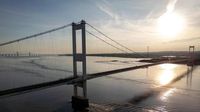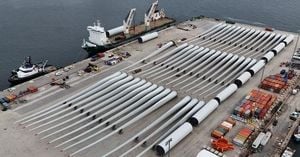The M48 Severn Bridge, a vital artery connecting England and Wales, was abruptly closed in both directions on September 20, 2025, as fierce winds swept across the region. The closure, which spanned the stretch between Junction 2 A466 Wye Valley Link Road and Junction 1 A403 at Aust, left motorists scrambling to adjust their travel plans and raised fresh concerns about the impact of increasingly volatile weather on the United Kingdom’s transport infrastructure.
According to BBC News, National Highways officials made the decision to shut the bridge after wind gusts were forecast to reach up to 75 miles per hour. The agency quickly rerouted traffic via the M4 Prince of Wales Bridge, which, despite the turbulent weather, remained open to all vehicles. The diversion, though necessary for safety, meant that drivers faced longer journeys and potential delays—a situation that seemed all too familiar for those who regularly traverse the Severn estuary.
“Motorists are advised to plan their routes in advance and allow extra time to travel,” National Highways stated, as cited by BBC. The warning was echoed by local authorities and travel services across the affected areas, who urged drivers to check the latest updates before setting out. For many, the closure was a stark reminder of the unpredictable power of nature and the challenges it poses to even the most robust infrastructure.
The timing of the closure could hardly have been worse. As the weekend approached, dozens of flood alerts were already in place across England and Wales, with the Met Office warning of stormy conditions expected to persist over the coming days. The agency indicated that some of the strongest winds would likely be felt along the Bristol Channel and the west coast of Wales—regions that have historically borne the brunt of Atlantic storms sweeping in from the southwest.
“Wind gusts could reach up to 75 mph as the country is hit with stormy conditions over the coming days,” the Met Office said, according to BBC. Such speeds are not only hazardous for vehicles—especially high-sided lorries and lighter cars—but also threaten to exacerbate flooding in low-lying areas, where rivers and drainage systems are already under strain from heavy rainfall.
Flood alerts, as reported by BBC, were not limited to the Severn estuary. From Yorkshire to Cornwall, emergency services and local councils were on high alert, monitoring river levels and preparing for possible evacuations if water breached critical thresholds. The cumulative effect of wind and rain, meteorologists warned, could lead to localized disruptions, property damage, and power outages.
For residents and commuters in the Severn area, the bridge closure was more than just an inconvenience—it was a disruption to daily life, commerce, and even emergency services. The M48 Severn Bridge, opened in 1966, has long served as a key link between South West England and South Wales. While its younger sibling, the M4 Prince of Wales Bridge (opened in 1996), offers a modern alternative, the two routes together form the backbone of cross-border movement for goods, services, and people.
“The M48 closure is in place between J2 A466 Wye Valley Link Road and J1 A403 at Aust,” multiple official statements confirmed. For many local businesses—especially those reliant on timely deliveries—the sudden redirection of traffic added hours to journeys and increased costs. Hauliers, taxi drivers, and delivery services all faced the prospect of longer detours and uncertain arrival times.
Yet, as frustrating as the closure was, safety remained the overriding concern. The history of the Severn crossings is peppered with incidents where high winds have forced temporary shutdowns. The design of the bridges, though robust, cannot fully mitigate the risks posed by extreme weather. Vehicles can be buffeted or even overturned by sudden gusts, and debris carried by the wind can create additional hazards. Authorities, therefore, have little choice but to act decisively when forecasts signal danger.
“Some of the strongest winds are likely to be along the Bristol Channel and the west coast of Wales,” the Met Office reiterated in its latest advisory. The agency’s meteorologists pointed to a powerful Atlantic low-pressure system as the culprit, bringing not only high winds but also bands of heavy rain. These conditions, they said, are likely to persist, making further disruptions possible as the storm system moves eastward.
The wider context for these weather events is the ongoing conversation about climate change and its impact on the UK’s weather patterns. While individual storms cannot be directly attributed to global warming, scientists note that a warmer atmosphere can hold more moisture, leading to heavier rainfall and more intense storms. The frequency of severe weather warnings and infrastructure closures has increased in recent years, prompting calls for greater investment in resilience and adaptation.
For now, though, the focus remains on immediate safety and recovery. National Highways and local police worked throughout the day to manage the diversion and ensure that the M4 Prince of Wales Bridge could handle the additional traffic load. Emergency services remained on standby, ready to respond to incidents ranging from stranded vehicles to flood-related rescues.
Meanwhile, the public was encouraged to stay informed. “Follow BBC Bristol on Facebook, X and Instagram,” the broadcaster advised, highlighting the importance of real-time updates in fast-moving situations. The BBC also invited residents to share their experiences and story ideas, recognizing that community input is vital in understanding the true impact of such disruptions.
As the storm continued to batter the region, many found themselves reflecting on the delicate balance between human engineering and the forces of nature. The Severn Bridge, an icon of mid-20th-century design, has weathered countless storms over its nearly sixty-year history. Yet, as this latest closure demonstrated, there are times when even the most enduring structures must yield to the elements.
For drivers, residents, and businesses across England and Wales, the hope is that the current round of stormy weather will soon abate, allowing life—and travel—to return to normal. Until then, patience, caution, and a close eye on the forecast will be the watchwords for anyone planning to cross the Severn.




